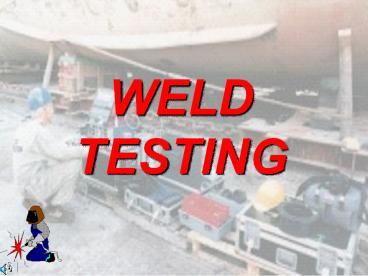Weld testing - PowerPoint PPT Presentation
Title:
Weld testing
Description:
Defects occur during welding which affect the quality and hardness of the plate ... Ductility. Fusion and penetration. BEND TEST. Bend through 180O ... – PowerPoint PPT presentation
Number of Views:9406
Avg rating:3.0/5.0
Title: Weld testing
1
WELDTESTING
2
DESTRUCTIVE AND
NON-DESTRUCTIVE
3
DESTRUCTIVE TESTING
- These can be divided into two parts,
- Tests capable of being performed in the
workshop. - Laboratory tests.
- microscopic-macroscopic , chemical and corrosive.
4
REASONS
- Defects occur during welding which affect the
quality and hardness of the plate - Other defects occur through lack of knowledge of
and skill of the welder - For the training of welders
5
WORKSHOP TESTS
- TENSILE BENDING
- IMPACT HARDNES
- FATIGUE CRACKING
6
TENSILE
- Material is sectioned and edges rounded of to
prevent cracking. - Punch marks are made to see elongation.
7
TENSILE
8
BEND TESTING
- Shows
- Physical condition of the weld
- Determine welds efficiency
- Tensile strength
- Ductility
- Fusion and penetration
9
BEND TEST
- Bend through 180O
- the specimen should be a minimum of 30mm wide
- The fulcrums diameter is 3x thickness of the
plate - The bottom rollers have a distance of the
diameter of the former 2.2 times the
thickness of the plate - Upper and lower surfaces ground or filed flat and
edges rounded off. - the tests should be one against the root -another
against the face ,and in some cases a side bend.
10
Root bend
11
FACE BEND
12
ANY QUESTIONS
13
IMPACT
- CHARPY AND IZOD
- Gives the toughness and shock loading of the
material and weld at varying temperatures with a
notch such as under cut - The measurement is the energy required to to
break a specimen with a given notch - 2mm depth at a 45obevel or a U notch.
14
TEST MACHINE
15
(No Transcript)
16
CHARPY
17
IZOD
18
ANY QUESTIONS
19
HARDNESS TESTS.
- This gives the metals ability to show resistance
to indentation which show its resistance to
wear and abrasion. - The tests are
- Brinell
- Rockwell
- Vickers diamond pyramid
- Scleroscope
20
VICKERS HARDNES
21
(No Transcript)
22
(No Transcript)
23
FATIGUE
- the testing of Material that is subject to
fluctuating loads - HAIGH Electro magnetic tester.
- WOHLER Uses rotating chuck with weight
24
CRACKING
- REEVES Test study the hardening and cracking of
welds. - The compatibility of electrodes for the metal
being joined.
25
CRACKING
- Three Sides Are Welded With Known Compatible
Electrodes. - The front edge is welded with the test electrode.
- if incompatible it will crack.
26
MICROSCOPIC
- Used to determine the actual structure of the
weld and parent metal - Up to 50,000 times magnification with an electron
beam microscope - Polishing must be of a very high standard
27
MACROSCOPIC
- Examined using a magnifying glass .
- magnification from 2 to 20 time.
- it will show up slag entrapment or cracks .
- polishing not as high as micro.
28
ETCHING REAGENTS
- These are acids used to show up different
structures in metals - For steels the most common is 1-2 nitric acid
in distilled water or alcohol. - Aluminum uses a solution of 10-20caustic soda in
water
29
HAVE YOU ANY QUESTIONS
30
- NON-DESTRUCTIVE
- TESTING
31
(No Transcript)
32
VISUAL
- While welding
- The rate the electrode melts
- The way the weld metal flows
- Sound of the arc
- The light given of
- After welding
- Under cut
- Lack of root fusion
- Any pin holes from gas or slag
- Amount of spatter
- Dimensions of weld
33
DYE PENETRANTS
- These are an aid to visual inspection
- Will only find surface defects
- Use correct type
34
DYE PENETRANTS
35
DYE PENETRANTS
- Types
- Red
- Flouresant
- CAUTION
- Oil based
- Water washable
36
DETECTION
37
MAGNETIC PARTICLE
- Mainly for surface defects
- Some sub surface defects can be found
- Only ferrous metal
38
ACOUSTICS
- Striking with a rounded object
- Ringing tone if no defect
- Tone changes when object is cracked
39
APPLICATION OF A LOAD
- Used to test pressure vessels
- Pipe lines
- The item for testing is filled with water or oil
it is then pressurised using a pump - A safety valve is set 1.5 to 2 times below the
working pressure.
40
(No Transcript)
41
PRESSURE TEST
42
RADIOGRAPHIC
- X-RAY
- GAMMA RAY
- Electro magnetic radiation of short duration
- Both of these methods are a danger to health
43
X- RAY
44
(No Transcript)
45
(No Transcript)
46
X-RAY VIEWER
- Pictures taken are viewed as negatives
- will only give flat image not in three
dimensional - darkened area must be used for viewing
47
ULTRASONIC TESTING
- This uses high pitched sound
- The sound will not pass through an air gap so
bounces back and is picked up on a receiver - The reader is a oscilloscope
48
ULTRA SONIC
49
(No Transcript)
50
(No Transcript)
51
THIS IS THE END OF THE
LESSON
- ARE THERE ANY QUESTIONS































